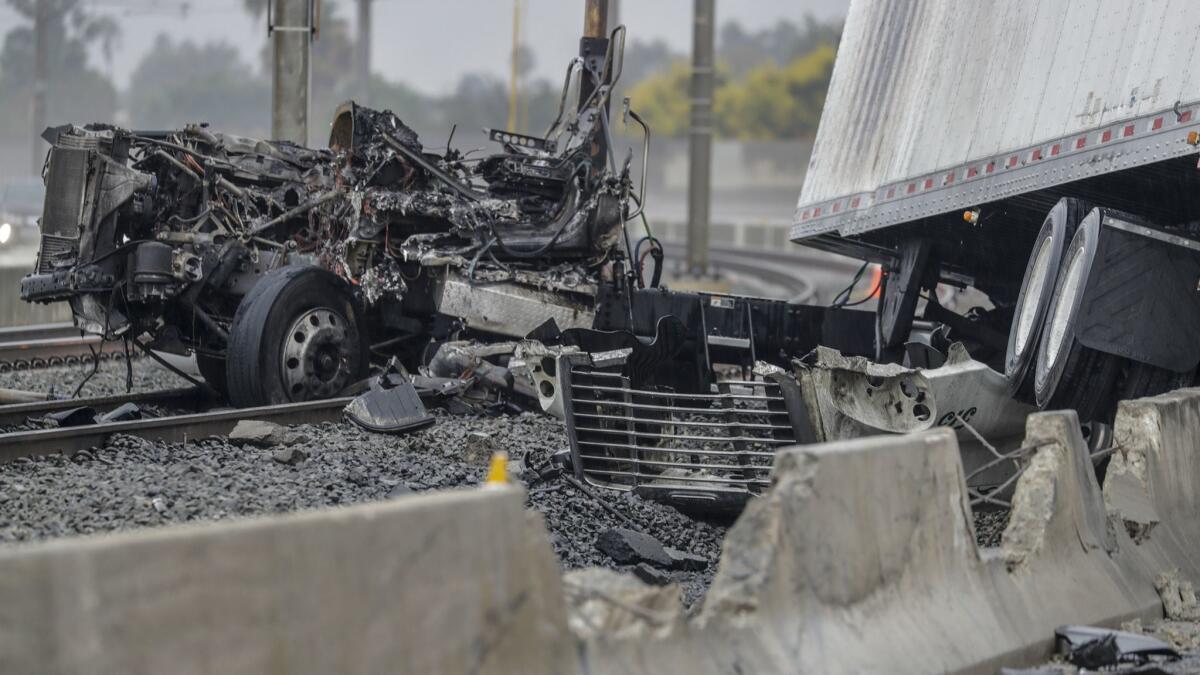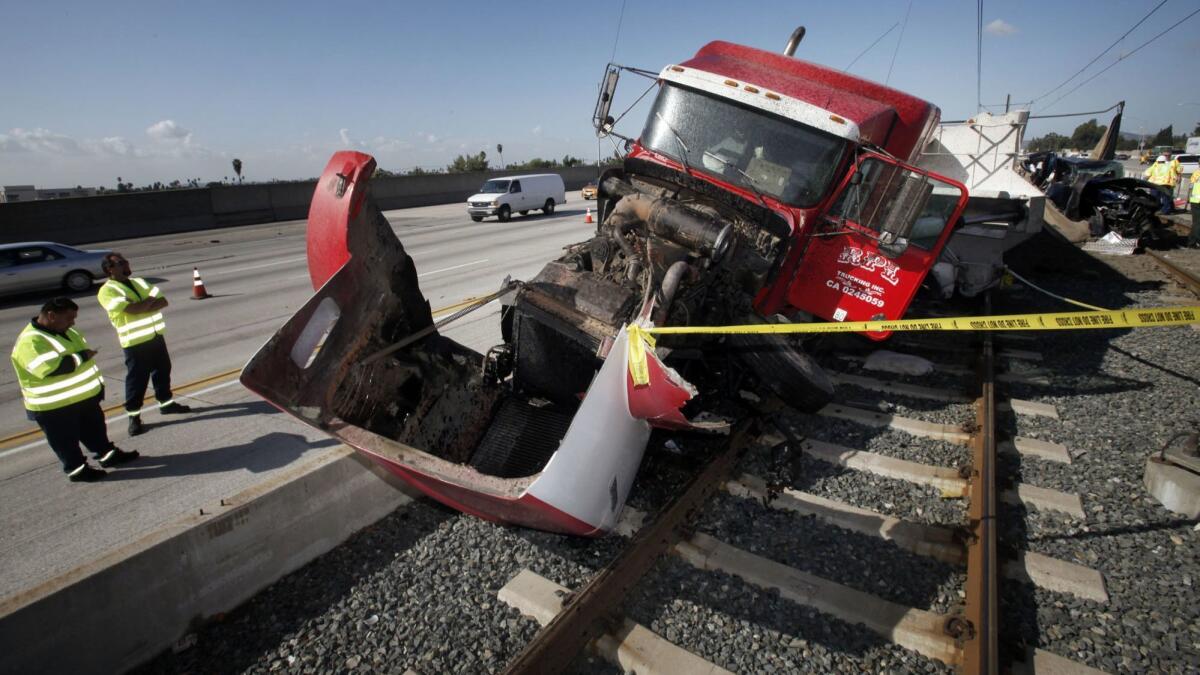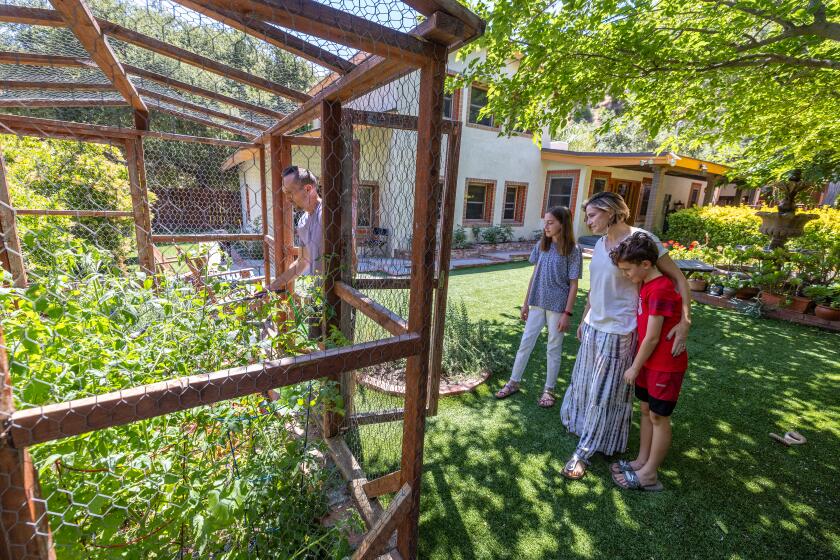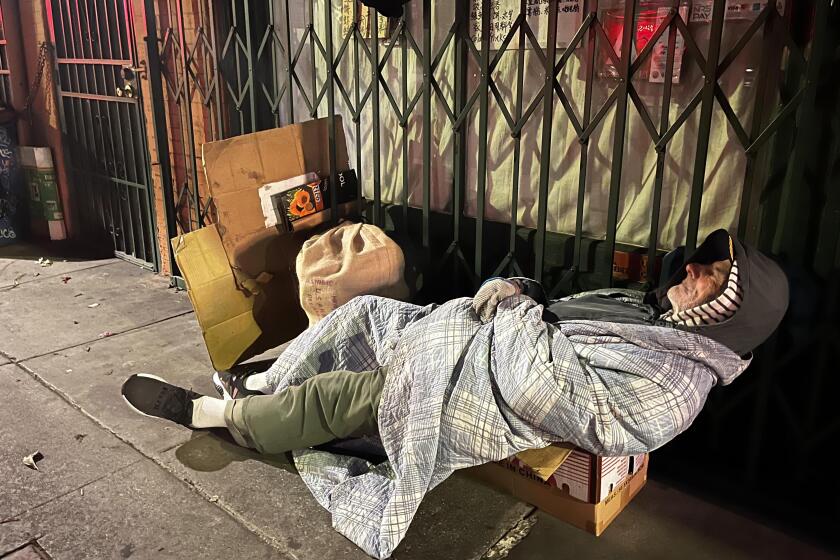Trucks on the 210 Freeway keep crashing onto the Gold Line. A fix could get expensive

In April of last year, a traffic collision in the middle of the night sent a FedEx truck crashing across the 210 Freeway in Pasadena and onto the tracks of the Metro Gold Line, which is separated from the roadway by a squat concrete barrier.
The collision shut down the Gold Line through the San Gabriel Valley for more than a day, and caused $137,959 in damage to train tracks, power poles and overhead wires.
Two more crashes would follow in the next six months. In all, in the last decade, 10 trucks and one sedan have crashed onto the Gold Line along the six-mile stretch where the tracks run in the 210’s median.
All but two collisions occurred in the last five years, an increase in frequency that officials say they cannot explain. Six of the 11 crashes occurred while the Gold Line was running, stoking concerns that a truck could someday strike a station or a train with riders on board.
How to prevent such a crash is becoming an increasingly costly question. Later this month, the Metropolitan Transportation Authority is considering doubling the budget — to $22.6 million — to design 12 miles of new concrete barriers aimed at beefing up the line’s protections.
The original $11-million estimate, approved last summer, reflected engineers’ assumptions that fixing the problem would be as simple as swapping out the 210’s barriers for a taller, sturdier model, said Androush Danielians, Metro’s executive engineering officer.
Since then, he said, engineers have realized that the narrow median leaves little room for crews and equipment to maneuver, and that they will need to shut down the 210’s carpool lanes through Pasadena for as long as two years.
“There’s just very little room to do the work out there,” Richard Clarke, Metro’s chief program management officer, said last month. “It’s a very difficult, complex design.”
The partial shutdown of the 210, a popular truck route, will trigger an increase in cut-through traffic in Pasadena. Metro plans to complete a congestion analysis and an air-quality study, adding to the project’s cost and schedule.

The replacement will happen in two phases, Danielians said, because “there’s no way we are going to close six miles of the freeway at the same time.”
Construction will start six to nine months after Metro finishes environmental work, which should take about a year, he said.
“We’re just glad they’re doing it,” said Pasadena spokeswoman Lisa Derderian. Pasadena firefighters and police officers, she said, have become accustomed to responding to crashes on the 210 and the Gold Line, some with fatalities.
The precast concrete barriers along the Gold Line are just shy of three feet high, with a familiar K-rail shape: a wide base that tapers slightly to a straight, vertical wall.
The barriers were installed in 1969 and 1976, when the roadway was built, said Caltrans spokeswoman Lauren Wonder. Until the 1990s, they separated freeway traffic from freight trains running through the median.
When the Gold Line opened, in 2003, Metro largely left the barriers intact, spokesman Brian Haas said. The line was built by the Foothill Gold Line Construction Authority, with designs from Metro and with approval for freeway-related elements from Caltrans, said spokeswoman Lisa Levy Buch.
In the last 15 years, trucks have become taller and heavier, and the angle and height of the barriers are less effective at repelling speeding vehicles, Danielians said.
“At the time they were being built, it wasn’t considered a flaw,” he said. “Now, it’s a flaw.”

Metro’s Green Line runs down the middle of the 105 Freeway for 17 of its 20 miles and has never had a truck crash on the tracks. The freeway is the newest in Los Angeles, with few curves and a wider buffer zone between travel lanes and the train.
The Green Line’s barriers are taller and sturdier. They also have fencing on top, while the Gold Line’s do not.
Metro’s new design for the 210 calls for barriers that are 4 feet, 8 inches tall, with a smoother edge that is designed to force truck wheels back onto the freeway.
Of the proposed $22.6-million budget, 89% would go toward consultants to finish the project’s design and clear it with Caltrans, records show. The budget does not include construction costs, which will be in the millions of dollars.
On a recent weekday, a Gold Line train juddered slightly as it navigated around a curve west of the Sierra Madre Villa station, in an area where five of the crashes have taken place.
Michelle Abed, who takes the Gold Line to downtown every weekday, said the series of crashes last year made her more wary of riding. It “feels like a matter of time,” she said, until a truck hits a train.
Some drivers in the carpool lane were so close to the train’s windows that passengers could see the dogs, fast food bags and cellphones that the drivers held in their laps.
“It feels like they’re about a foot away,” Abed said as she stepped off a Gold Line train at the Allen station. “It makes me nervous. Any change would be better than this.”
Until construction starts, Metro and Caltrans are relying on signs installed last year that instruct truck drivers to stay in the 210’s two right-hand lanes, and maintain speeds of less than 55 mph.
The signs alone may not stop truck drivers from reckless behavior, Clarke said, but they clear the way for the California Highway Patrol to ticket the worst offenders.
“The barrier is able to stop, for the most part, smaller vehicles and vehicles that are going at a permissible speed,” Danielians said. “As for weather, we can just pray.”

Twitter: @laura_nelson
More to Read
Start your day right
Sign up for Essential California for news, features and recommendations from the L.A. Times and beyond in your inbox six days a week.
You may occasionally receive promotional content from the Los Angeles Times.






